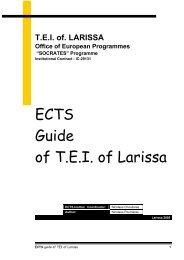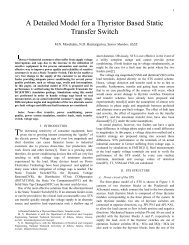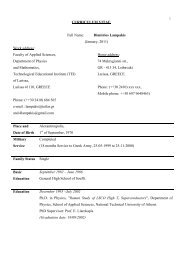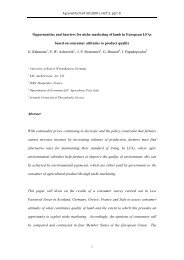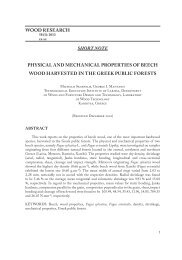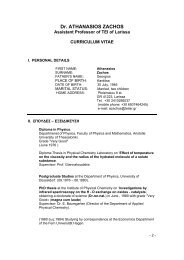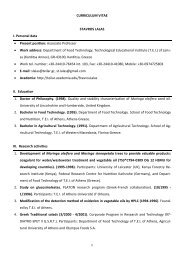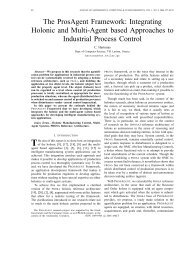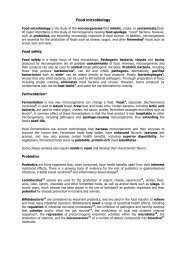Risk classification of projects in EU operational ... - IEEE Xplore
Risk classification of projects in EU operational ... - IEEE Xplore
Risk classification of projects in EU operational ... - IEEE Xplore
You also want an ePaper? Increase the reach of your titles
YUMPU automatically turns print PDFs into web optimized ePapers that Google loves.
<strong>Risk</strong> <strong>classification</strong> <strong>of</strong> <strong>projects</strong> <strong>in</strong> <strong>EU</strong> <strong>operational</strong> programmes<br />
accord<strong>in</strong>g to their S-curve characteristics: A case study approach.<br />
P. G. Ipsilandis 1<br />
1 Department <strong>of</strong> Project Management, Technological Education Institute <strong>of</strong> Larissa, Greece<br />
(ipsil@teilar.gr)<br />
Abstract – Project portfolios <strong>of</strong> <strong>EU</strong> programme organizations<br />
typically conta<strong>in</strong> hundreds or even thousands <strong>of</strong> diverse<br />
<strong>projects</strong>, carried out by public or private organizations<br />
each be<strong>in</strong>g at a different level <strong>of</strong> organizational project management<br />
maturity. As a result an embedded risk exists regard<strong>in</strong>g<br />
the allocation <strong>of</strong> funds to potential project organizations<br />
which could lead to high opportunity costs from not<br />
be<strong>in</strong>g able to fully utilize the programme’s available funds.<br />
Spott<strong>in</strong>g early signs <strong>of</strong> underperformance is crucial for programme<br />
managers <strong>in</strong> their decision mak<strong>in</strong>g concern<strong>in</strong>g the<br />
implementation <strong>of</strong> potential corrective actions, or reallocation<br />
<strong>of</strong> funds. Reduction <strong>of</strong> this type <strong>of</strong> risk can only be<br />
achieved by monitor<strong>in</strong>g the cost progress <strong>of</strong> each project<br />
aga<strong>in</strong>st its approved budget.<br />
This paper presents a methodological framework applied<br />
to a real case study where <strong>projects</strong> can be classified<br />
accord<strong>in</strong>g to the shape <strong>of</strong> their S-curve <strong>in</strong> a way that provides<br />
a strong <strong>in</strong>dication about their f<strong>in</strong>al performance.<br />
Keywords - Programme management, Project S-Curves,<br />
European Programmes<br />
I. INTRODUCTION<br />
The European Union (<strong>EU</strong>) <strong>in</strong> its effort to materialize<br />
its commitment to economic and social cohesion with<strong>in</strong><br />
Europe, funds a large number <strong>of</strong> <strong>projects</strong> at member states<br />
through the establishment and operation <strong>of</strong> regional and<br />
sectoral programmes. Almost 23,000 such <strong>projects</strong> have<br />
be<strong>in</strong>g funded <strong>in</strong> Greece <strong>in</strong> the years between 2000 and<br />
2006 grouped <strong>in</strong> 24 <strong>operational</strong> programmes, with a total<br />
budget <strong>of</strong> 25 billion euros. Each <strong>of</strong> these programmes is<br />
divided <strong>in</strong>to a number <strong>of</strong> ma<strong>in</strong> l<strong>in</strong>es <strong>of</strong> action, called axis,<br />
which identify its strategic priorities, which are further<br />
subdivided <strong>in</strong>to sub programmes called measures that<br />
<strong>in</strong>clude a number <strong>of</strong> similar <strong>projects</strong>. Each programme is<br />
managed by a specifically established organization called<br />
Programme Management Authority (PMA).<br />
Accord<strong>in</strong>g to Turner [8], a programme is def<strong>in</strong>ed by<br />
as a temporary organization <strong>in</strong> which a group <strong>of</strong> <strong>projects</strong><br />
are managed together to deliver higher order strategic<br />
objectives not delivered by any <strong>of</strong> the <strong>projects</strong> <strong>in</strong> their<br />
own. Thus the ma<strong>in</strong> objective <strong>in</strong> a programme is the delivery<br />
<strong>of</strong> a strategic objective, totally different <strong>of</strong> that <strong>of</strong> a<br />
project portfolio where the ma<strong>in</strong> issue is the efficient<br />
management <strong>of</strong> resources and risk ([7], [9], [10]). Programmes<br />
themselves do not deliver <strong>in</strong>dividual project<br />
objectives. They create benefit through better project organization<br />
(i.e. improved coord<strong>in</strong>ation, effective knowledge<br />
transfer and resource utilization) and better alignment<br />
<strong>of</strong> the <strong>projects</strong> with the requirements, goals and culture<br />
<strong>of</strong> the master organization ([7], [11]).<br />
For member nations the exploitation <strong>of</strong> <strong>EU</strong> programmes<br />
it is important because they constitute a considerable<br />
driver for economic and regional development,<br />
contribut<strong>in</strong>g to GNP growth and provid<strong>in</strong>g employment.<br />
Thus, a key priority <strong>of</strong> national authorities through the<br />
correspond<strong>in</strong>g PMA is the absorption <strong>of</strong> as large portion<br />
<strong>of</strong> the available funds as possible.<br />
The PMA is responsible for manag<strong>in</strong>g the <strong>operational</strong><br />
programme, the implementation <strong>of</strong> the operation <strong>in</strong>clusion<br />
procedures, and the monitor<strong>in</strong>g <strong>of</strong> the progress <strong>of</strong> the programme’s<br />
<strong>projects</strong> ma<strong>in</strong>ly with regard to the eligibility <strong>of</strong><br />
the expenses and the rate <strong>of</strong> absorb<strong>in</strong>g the allocated budget<br />
per project.<br />
Exclud<strong>in</strong>g a small number <strong>of</strong> programmes / sub programmes<br />
concern<strong>in</strong>g large scale <strong>in</strong>frastructures, which are<br />
project specific driven, the rest <strong>of</strong> the <strong>EU</strong> programmes<br />
and especially those <strong>in</strong>clud<strong>in</strong>g ‘s<strong>of</strong>t’ actions (i.e. education,<br />
tra<strong>in</strong><strong>in</strong>g, employment, entrepreneurship, etc.) <strong>in</strong>clude<br />
large number <strong>of</strong> <strong>projects</strong>.<br />
Potential beneficiaries <strong>of</strong> each programme, both <strong>in</strong><br />
the public and private sector submit their proposals, follow<strong>in</strong>g<br />
a public call for expression <strong>of</strong> <strong>in</strong>terest. Projects are<br />
approved by the PMA after a selection and evaluation<br />
process, accord<strong>in</strong>g to a top down approach, where a total<br />
budget is set for each measure along with a ceil<strong>in</strong>g on the<br />
budget for each potential project. Approved <strong>projects</strong> must<br />
be completed with<strong>in</strong> specific time, at the agreed budget<br />
with no trade <strong>of</strong>fs between duration, cost and quality be<strong>in</strong>g<br />
allowed.<br />
In the case where <strong>projects</strong> do not consume their<br />
agreed budget and/or not fulfill<strong>in</strong>g their scope the PMA<br />
can reallocate part <strong>of</strong> or the entire budget to other beneficiaries<br />
<strong>in</strong> the same or other actions or sub programmes.<br />
Achiev<strong>in</strong>g a high rate <strong>of</strong> absorption <strong>of</strong> the available funds<br />
is one <strong>of</strong> the ma<strong>in</strong> objectives for any PMA and for national<br />
economy. Therefore monitor<strong>in</strong>g <strong>of</strong> the <strong>projects</strong>’<br />
cumulative cost is essential <strong>in</strong> identify<strong>in</strong>g situations that<br />
may present a risk with respect to not consum<strong>in</strong>g significant<br />
part <strong>of</strong> the budget allocated to them.<br />
PMA operations are currently supported by a dedicated<br />
<strong>in</strong>tegrated <strong>in</strong>formation system (IIS) that provides <strong>in</strong>formation<br />
at different levels <strong>of</strong> detail extend<strong>in</strong>g from aggregate<br />
national figures down to sub-project level. Although<br />
IIS is very well structured, and it holds a vast<br />
amount <strong>of</strong> <strong>in</strong>formation, its design and functionality conforms<br />
to the typical characteristics <strong>of</strong> a management <strong>in</strong>formation<br />
system rather than a decision support system<br />
([5], [6]). With regard to the <strong>in</strong>formation needed for man-<br />
978-1-4244-4870-8/09/$26.00 ©2009 <strong>IEEE</strong><br />
613
Proceed<strong>in</strong>gs <strong>of</strong> the 2009 <strong>IEEE</strong> IEEM<br />
agement decisions at the PMAs, the ma<strong>in</strong> weaknesses <strong>of</strong><br />
IIS are i) that it provides only historical <strong>in</strong>formation on<br />
project progress and costs, as they are reported by project<br />
organizations without any validation or crosscheck <strong>of</strong> the<br />
f<strong>in</strong>ancial <strong>in</strong>formation aga<strong>in</strong>st the progress <strong>of</strong> a project and<br />
ii) that is has no model<strong>in</strong>g capacity about possible cost<br />
and time deviations.<br />
In this paper we present a methodology for classify<strong>in</strong>g<br />
<strong>projects</strong> <strong>of</strong> a programme with respect to their performance<br />
regard<strong>in</strong>g the absorption <strong>of</strong> the available budget,<br />
which is based on the widely accepted empirically established<br />
behavior <strong>of</strong> the project cost life - cycle [1], [4].<br />
The methodology is tested on real data drawn from a<br />
<strong>EU</strong> <strong>operational</strong> programme <strong>in</strong> Greece, lead<strong>in</strong>g to conclusions<br />
that show the applicability <strong>of</strong> the proposed approach.<br />
The rest <strong>of</strong> the paper is structured as follows: In the<br />
next section we present a formal description and mathematical<br />
notations <strong>of</strong> the proposed methodology. In section<br />
3 we describe the application <strong>of</strong> the proposed methodology<br />
to the case <strong>of</strong> the Operational Programme Education<br />
and Initial Vocational Tra<strong>in</strong><strong>in</strong>g (OPEVIT) <strong>of</strong> the 3rd<br />
Common Support Framework (CSF) and provide a set <strong>of</strong><br />
demonstrative results regard<strong>in</strong>g its applicability and versatility<br />
to <strong>EU</strong> Programme management. Section 4 presents<br />
the conclusions and suggestions for future research.<br />
II. THE PROPOSED METHODOLOGY<br />
A. Mathematical formulation <strong>of</strong> the S curve<br />
The proposed methodology is based on the pr<strong>in</strong>ciples<br />
<strong>of</strong> project management [1], [4] and on time series forecast<strong>in</strong>g<br />
[3], [2].<br />
Without loss <strong>of</strong> generality as it will be shown later, it<br />
can be assumed that the cumulative cost for the project <strong>of</strong><br />
a programme follows the well known S curve.<br />
The formal description <strong>of</strong> the curve is the one proposed<br />
by Mavrotas et al. [12], modified here so that it also<br />
reflects cases where the total expenditures at the end <strong>of</strong><br />
the project does not reach 100% <strong>of</strong> the committed budget.<br />
YT 1<br />
( ) = , 0, 0<br />
k( aT 1)<br />
1 e k > a ><br />
(1)<br />
+<br />
− −<br />
Both the doma<strong>in</strong> and range <strong>of</strong> the function are normalized<br />
values <strong>of</strong> time and expenditures as follows: T denotes<br />
the project elapsed time, normalized to a [0,1] scale,<br />
and is def<strong>in</strong>ed as the ratio <strong>of</strong> the elapsed time to the overall<br />
project duration :<br />
Time from Start<br />
T = (2)<br />
Project duration<br />
and Y(T) is the cumulative public expenditure (i.e. programme<br />
funds) at time T, also normalized to a [0-1] scale<br />
as follows:<br />
Pr oject expenditures at time T<br />
YT ( ) = (3)<br />
Total Budget<br />
The values <strong>of</strong> the parameters <strong>of</strong> the logistic function a<br />
and k determ<strong>in</strong>e the curvature and the slope <strong>of</strong> the curve<br />
giv<strong>in</strong>g a variety <strong>of</strong> shapes that could describe the project’s<br />
accumulated cost as it is shown <strong>in</strong> Fig. 1 <strong>of</strong> the next section.<br />
The maximum slope <strong>of</strong> the curve occurs at the po<strong>in</strong>t<br />
(1/a , 0,5) therefore for a value <strong>of</strong> a = 2 the curve is symmetrical<br />
hav<strong>in</strong>g its maximum slope at the middle <strong>of</strong> the<br />
project’s duration where 505 <strong>of</strong> the budget has been consumed<br />
and as a <strong>in</strong>creases the maximum slope moves to an<br />
earlier time. Thus high values characterize <strong>projects</strong> where<br />
the correspond<strong>in</strong>g cost curve starts ris<strong>in</strong>g soon after their<br />
approval, while small values correspond to <strong>projects</strong> the<br />
activities <strong>of</strong> which have a late start. Parameter k denotes<br />
the steepness <strong>of</strong> the curve. High values correspond to high<br />
escalation rates <strong>of</strong> the project’s cost and therefore activities,<br />
while lower values correspond to smoother curves.<br />
So, the specific shape <strong>of</strong> the S curve reflects the characteristics<br />
<strong>of</strong> the specific programme, the maturity <strong>of</strong> the<br />
<strong>projects</strong> selected by the PMA, the experience <strong>of</strong> the<br />
project organization, and the way specific <strong>projects</strong> are<br />
managed.<br />
It is easily verified that the modified logistic curve (1)<br />
has an upper limit equal to 1 as T approaches <strong>in</strong>f<strong>in</strong>ity.<br />
However at the end <strong>of</strong> the life cycle (T=1) the percentage<br />
<strong>of</strong> the budget that has been consumed by the project,<br />
which is called absorption ratio, is def<strong>in</strong>ed as:<br />
1<br />
Project absorption ratio: Y (1) = (4)<br />
+<br />
k( a 1)<br />
e − −<br />
1<br />
Hence the proposed formulation allows to model for the<br />
cases where <strong>projects</strong> <strong>of</strong> a programme do not cover 100%<br />
<strong>of</strong> their budget with<strong>in</strong> their normal duration as it is <strong>of</strong>ten<br />
the case.<br />
The normalization <strong>of</strong> the time and cost variables <strong>in</strong> the<br />
proposed mathematical formulation is necessary because<br />
similar <strong>projects</strong> can be characterized by comparable S-<br />
curves regardless any differences <strong>in</strong> their budget and duration.<br />
Also it can handle extensions <strong>in</strong> project duration<br />
and changes to the project’s budget that could take place<br />
dur<strong>in</strong>g their life cycle.<br />
B. Us<strong>in</strong>g S-curves for programme monitor<strong>in</strong>g and control<br />
S-curves is a common tool for monitor<strong>in</strong>g and controll<strong>in</strong>g<br />
project time and cost through the earned value<br />
analysis. Their use <strong>in</strong> programme management is multifold.<br />
They can be used to help programme managers to:<br />
1) Establish norms <strong>of</strong> acceptable cost vs. time patterns<br />
for the programme’s <strong>projects</strong> so that deviations from<br />
the norm can be early spotted and <strong>in</strong>vestigated.<br />
2) Identify dist<strong>in</strong>ct progress patterns for programmes<br />
or sub-programmes depend<strong>in</strong>g on the characteristics<br />
<strong>of</strong> the programme and the nature <strong>of</strong> the <strong>projects</strong><br />
<strong>in</strong>cluded <strong>in</strong> it..<br />
3) Forecast the expenses for a sub programme or<br />
the entire programme, through the aggregation <strong>of</strong> the fitted<br />
S-curves <strong>of</strong> the <strong>projects</strong> it conta<strong>in</strong>s, thus lead<strong>in</strong>g to a<br />
more efficient management <strong>of</strong> the programme’s budget.<br />
4) Analysis <strong>of</strong> S-curves for different programmes or<br />
groups <strong>of</strong> <strong>projects</strong> or project organizations could also pro-<br />
614
Proceed<strong>in</strong>gs <strong>of</strong> the 2009 <strong>IEEE</strong> IEEM<br />
vide useful <strong>in</strong>formation <strong>in</strong> cluster<strong>in</strong>g programmes / sub<br />
programmes or project organizations accord<strong>in</strong>g to parameters<br />
that def<strong>in</strong>e their fund absorption pattern.<br />
In the follow<strong>in</strong>g section, we will demonstrate how the<br />
analysis <strong>of</strong> the S-curves can provide valuable <strong>in</strong>formation<br />
<strong>in</strong> develop<strong>in</strong>g a control method for identify<strong>in</strong>g potentially<br />
risky <strong>projects</strong> with regard to meet<strong>in</strong>g their budget objectives.<br />
III. CASE STUDY APPLICATION<br />
A. Description <strong>of</strong> the sample data<br />
The Operational Programme <strong>of</strong> “Education and Initial<br />
Vocational Tra<strong>in</strong><strong>in</strong>g” (OPEIVT) is one <strong>of</strong> the 24 Operational<br />
Programmes <strong>of</strong> the 3 rd Common Support Framework<br />
(CSF) for Greece. Its overall budget amount<strong>in</strong>g to<br />
2,8 billion euros for the 2002 – 2006 period is used to<br />
fund approximately 2,000 <strong>projects</strong> classified <strong>in</strong> 5 axis <strong>of</strong><br />
action, and many sub-programmes.<br />
A sample <strong>of</strong> 177 <strong>projects</strong> selected based on two criteria:<br />
a) budget over 100,000€ and b) be<strong>in</strong>g completed or<br />
close to completion from the follow<strong>in</strong>g five subprogrammes<br />
concern<strong>in</strong>g Higher Education, where the<br />
project organizations were HE Institutes:<br />
a) Expansion <strong>of</strong> Higher Education<br />
b) Upgrade <strong>of</strong> Academic Libraries<br />
c) University-Industry Liaison Offices<br />
d) Enhancement <strong>of</strong> Industrial Tra<strong>in</strong><strong>in</strong>g<br />
e) Upgrade <strong>of</strong> HE Curriculum<br />
The total budget <strong>of</strong> the <strong>projects</strong> <strong>in</strong> the sample<br />
amounts to 262.5 million euros.<br />
B. Classification <strong>of</strong> <strong>projects</strong> based on their S-curve<br />
The various <strong>projects</strong> with<strong>in</strong> a programme exhibit different<br />
behavior with respect to their progress pattern<br />
which affects the rate <strong>of</strong> absorb<strong>in</strong>g the programme’s funds<br />
committed to them. Although similarities <strong>in</strong> the project’s<br />
scope, the nature <strong>of</strong> sub<strong>projects</strong> with<strong>in</strong> each project, and<br />
comparability <strong>of</strong> deliverables tend to align the programme’s<br />
<strong>projects</strong> on the same pattern regard<strong>in</strong>g the tim<strong>in</strong>g<br />
<strong>of</strong> expenditures, other factors such as the effectiveness<br />
<strong>of</strong> the project management team, the experience and maturity<br />
<strong>of</strong> the project organization, the size <strong>of</strong> the project,<br />
and other project particularities <strong>in</strong>troduce variations <strong>in</strong> the<br />
<strong>in</strong>dividual project S-curves.<br />
S<strong>in</strong>ce a major objective <strong>of</strong> a PMA is to ensure the<br />
maximum utilization <strong>of</strong> the programme’s budget, a <strong>classification</strong><br />
<strong>of</strong> the correspond<strong>in</strong>g S-curves <strong>of</strong> the <strong>projects</strong> <strong>of</strong><br />
the programme accord<strong>in</strong>g to how well and at what pace<br />
consume the funds committed to them, could provide <strong>in</strong>dications<br />
about <strong>projects</strong> that are underperformers and<br />
therefore can be considered as risky.<br />
Is such a <strong>classification</strong> possible and can it provide reliable<br />
<strong>in</strong>dications<br />
The shape <strong>of</strong> the S-curve (1) depends on the values <strong>of</strong><br />
the a and k parameters. The value <strong>of</strong> the parameter a or k<br />
for a specific project is considered to have a “low” or<br />
“high” value depend<strong>in</strong>g on whether it lies above or below<br />
the correspond<strong>in</strong>g median value <strong>of</strong> all <strong>projects</strong>. Thus each<br />
project is judged not to a preset standard but relative to<br />
the performance <strong>of</strong> the rest <strong>of</strong> the <strong>projects</strong> with<strong>in</strong> a programme.<br />
The use <strong>of</strong> median is necessary to avoid the <strong>in</strong>fluence<br />
<strong>of</strong> extreme cases (i.e. project with very low performance).<br />
The median values <strong>of</strong> the two parameters divide the<br />
set <strong>of</strong> the <strong>projects</strong> <strong>in</strong> four quadrants: The upper right (UR)<br />
quadrant (high a, high k) can be classified as the one represent<strong>in</strong>g<br />
<strong>projects</strong> that show an ideal behaviour with an<br />
early start and a steep slope, achieve almost 100% <strong>of</strong> their<br />
budget. The reverse situation is shown <strong>in</strong> <strong>projects</strong> classified<br />
<strong>in</strong> the lower left (LL) quadrant (low a, low k), where<br />
the <strong>projects</strong> have a late start and a smooth almost l<strong>in</strong>ear<br />
progress that end up well beh<strong>in</strong>d their budget. The upper<br />
left (UL) quadrant (high a low k) represent <strong>projects</strong> with a<br />
fast start but slower progress at the later stages than <strong>projects</strong><br />
<strong>in</strong> the UR quadrant, while the lower right (LR) quadrant<br />
(low a, high k) <strong>in</strong>cludes <strong>projects</strong> with a late start but<br />
an aggressive progress at the last half <strong>of</strong> the project cycle.<br />
Fig. 1 illustrates the results <strong>of</strong> the application <strong>of</strong> the<br />
Four Quadrant S-curve <strong>classification</strong> model to the 35 <strong>projects</strong><br />
conta<strong>in</strong>ed <strong>in</strong> the subprograme “University-Industry<br />
Liaison Offices” <strong>of</strong> OPEIVT. The diagram <strong>in</strong> each quadrant<br />
conta<strong>in</strong>s the S-curves <strong>of</strong> the correspond<strong>in</strong>g <strong>projects</strong>.<br />
C Relationship between <strong>classification</strong> <strong>of</strong> S-curves and<br />
project performance<br />
The <strong>classification</strong> system that was demonstrated <strong>in</strong><br />
the previous section will be <strong>of</strong> a practical value only if it<br />
is proved that it is related to the performance <strong>of</strong> the <strong>projects</strong><br />
<strong>in</strong> terms <strong>of</strong> meet<strong>in</strong>g their budgets.<br />
Table I shows the distribution <strong>of</strong> the 177 <strong>projects</strong> <strong>in</strong><br />
the sample, <strong>in</strong>to quartiles, accord<strong>in</strong>g to the budget absorption<br />
ratio they achieved at completion.<br />
TABLE I.<br />
QUARTILES OF BUDGET ABSORPTION RATIO<br />
Quartile M<strong>in</strong> Max Total Budget(€)<br />
No <strong>of</strong> Projects<br />
4 th 95,21% 100% 52.745.985,7 44<br />
3 rd 88,66% 95,21% 82.463.061,9 44<br />
2 nd 80,63% 88,66% 85.416.524,7 44<br />
1 st 6,6% 80,63% 44.579.488,2 45<br />
The top 25% <strong>projects</strong> achieved an absorption ratio<br />
higher than 95%, while half <strong>of</strong> the <strong>projects</strong> were over<br />
88,66% and 75% <strong>of</strong> the <strong>projects</strong> absorbed more than 80%<br />
<strong>of</strong> their budget.<br />
615
Proceed<strong>in</strong>gs <strong>of</strong> the 2009 <strong>IEEE</strong> IEEM<br />
Fig. 1: Four Quadrant S-curve <strong>classification</strong> model<br />
To test the hypothesis, whether the <strong>classification</strong> <strong>of</strong><br />
the <strong>projects</strong> accord<strong>in</strong>g to S-curves is related to their performance<br />
as it is measured by the budget absorption ratio,<br />
the values <strong>of</strong> parameters a and k <strong>of</strong> the fitted S-curves for<br />
each <strong>of</strong> the 177 <strong>projects</strong> <strong>in</strong> the sample were estimated,<br />
produc<strong>in</strong>g the follow<strong>in</strong>g distribution statistics:<br />
TABLE II.<br />
RANGE OF VALUES FOR S-CURVE PARAMETERS (a, k)<br />
Parameters M<strong>in</strong><br />
25%<br />
75%<br />
Median<br />
Quartile<br />
Quartile<br />
Max<br />
a 0,78 1,47 1,61 1,73 2,11<br />
k 2,02 2,91 3,74 5,59 11,35<br />
The <strong>projects</strong> were classified accord<strong>in</strong>g to the Four<br />
Quadrants (UR, UL, LL, LR) Classification Model, and<br />
the <strong>classification</strong> results were compared aga<strong>in</strong>st the performance<br />
<strong>of</strong> the <strong>projects</strong> as they are presented <strong>in</strong> table III.<br />
Performance<br />
Quartile<br />
TABLE III.<br />
S-CURVE CLASSIFICATION VS. PROJECT PERFORMANCE<br />
S-Curve quadrant<br />
UR UL LR LL<br />
4 th 81% 15% 15%<br />
3 rd 19% 44% 25% 3%<br />
2 nd 37% 21% 38%<br />
1 st 4% 38% 59%<br />
The data <strong>in</strong> table III show a strong relationship between<br />
the S-curve <strong>classification</strong> and the budget performance<br />
<strong>of</strong> each project. All <strong>projects</strong> with S-curves <strong>in</strong> the UR<br />
quadrant have a budget absorption ratio above the median<br />
and 81% <strong>of</strong> them are <strong>in</strong> the top 25% percentile with respect<br />
to budge performance. Exactly the opposite picture<br />
is shown for <strong>projects</strong> with S-curves <strong>in</strong> the LL quadrant,<br />
where almost all <strong>of</strong> them perform below the median level.<br />
Between the two <strong>in</strong>termediate classes, <strong>projects</strong> <strong>in</strong> the UL<br />
quadrant perform better than those <strong>in</strong> the LL right.<br />
Pair wise statistical tests <strong>of</strong> equality <strong>of</strong> means for the<br />
comparison <strong>of</strong> the mean absorption rate between the 4<br />
classes <strong>of</strong> S-curves confirm the previous conclusions, as<br />
shown <strong>in</strong> Table IV.<br />
Thus the four classes <strong>of</strong> the S-curves are directly associated<br />
with the performance <strong>of</strong> a programme’s project,<br />
and can be used to order the <strong>projects</strong> <strong>of</strong> a programme<br />
based on their performance as follows:<br />
I. Projects with a fast start (high a) and sharp growth<br />
(high k)<br />
II. Projects with a fast start (high a) and slow growth<br />
(low k)<br />
III. Projects with a slow start (low a) but sharp growth<br />
(high k)<br />
IV. Projects with a slow start (low a) and slow growth<br />
(low k)<br />
616
Proceed<strong>in</strong>gs <strong>of</strong> the 2009 <strong>IEEE</strong> IEEM<br />
TABLE IV.<br />
ONE SIDE T-TEST FOR PAIR COMPARISON OF THE MEAN BUDGET ABSORPTION RATE<br />
Mean budget<br />
absorption rate<br />
UR 97,4% —<br />
S-Curve quadrant<br />
UR UL LR LL<br />
97,4% 89,5% 78,3% 65,4%<br />
-10,15 1<br />
0,000 2 *<br />
UL 89,5% —<br />
-6,50<br />
0,000*<br />
-3,75<br />
0,0002*<br />
LR 78,3% —<br />
-7,74<br />
0,000*<br />
-5,79<br />
0,000*<br />
-2,57<br />
0,006*<br />
LL 65,4% —<br />
1<br />
T-statistic value<br />
2<br />
p-value <strong>of</strong> one sided test: Probability{T>critical value}<br />
* Significant at the 0,01 level<br />
The <strong>classification</strong> process is based on the relative<br />
comparison between the <strong>projects</strong> <strong>of</strong> a programme with<br />
respect to both <strong>classification</strong> elements: the characteristics<br />
<strong>of</strong> the associated S-curve (start and speed) and the performance<br />
related to budget absorption. Thus <strong>in</strong>dividual<br />
characteristics <strong>of</strong> a given programme that can affect the<br />
performance <strong>of</strong> the <strong>projects</strong> conta<strong>in</strong>ed <strong>in</strong> it are recognised<br />
and accounted for, s<strong>in</strong>ce the values <strong>of</strong> the <strong>classification</strong><br />
criteria are determ<strong>in</strong>ed with<strong>in</strong> each programme.<br />
IV. CONCLUSIONS<br />
Monitor<strong>in</strong>g the rate <strong>of</strong> public expenditures for programmes<br />
f<strong>in</strong>anced by the <strong>EU</strong> is one <strong>of</strong> the most critical<br />
factors for the PMAs, <strong>in</strong> reduc<strong>in</strong>g the opportunity cost <strong>of</strong><br />
not utiliz<strong>in</strong>g available funds, s<strong>in</strong>ce the objective <strong>of</strong> the <strong>EU</strong><br />
programmes is to maximize social end economic benefits<br />
fro the beneficial country<br />
<strong>EU</strong> programmes on s<strong>of</strong>t actions like education, entrepreneurship,<br />
employment etc. follow a top down approach<br />
<strong>in</strong> allocat<strong>in</strong>g available funds to selected <strong>projects</strong>. These<br />
types <strong>of</strong> <strong>projects</strong> <strong>in</strong> contrast with hard <strong>projects</strong> do not<br />
have a predictable pattern <strong>of</strong> expenditures that follows the<br />
completion <strong>of</strong> specific deliverables at discrete times, and<br />
expenditures can be considered as occurr<strong>in</strong>g cont<strong>in</strong>uously.<br />
Empirical analysis <strong>of</strong> a specific case study based on<br />
historical data for five sub programmes <strong>of</strong> a sectoral Operational<br />
Programme for Education and Initial Tra<strong>in</strong><strong>in</strong>g <strong>in</strong><br />
Greece shows that an analysis <strong>of</strong> the project’s S-curves<br />
can provide useful <strong>in</strong>formation to PMAs <strong>in</strong> their effort to<br />
f<strong>in</strong>d efficient methods for project monitor<strong>in</strong>g.<br />
Estimation <strong>of</strong> the S-curve parameters for the <strong>projects</strong><br />
<strong>of</strong> a programme can be used to classify the <strong>projects</strong> <strong>in</strong><br />
categories based on expected performance, and help <strong>in</strong><br />
identify<strong>in</strong>g <strong>projects</strong> that could present a risk to the programme.<br />
Further research us<strong>in</strong>g multicriteria analysis or cluster<strong>in</strong>g<br />
techniques can be carried out <strong>in</strong> order to <strong>in</strong>vestigate<br />
the existence <strong>of</strong> any causal relationships between the <strong>classification</strong><br />
results <strong>of</strong> the project’s S-curves and parameters<br />
that characterize the project and / or programme organization<br />
such as the size <strong>of</strong> the project, the type, size and maturity<br />
<strong>of</strong> the project organization, the nature <strong>of</strong> the project,<br />
the project selection process, the adm<strong>in</strong>istrat<strong>in</strong>g PMA<br />
team etc.<br />
Furthermore the results <strong>of</strong> the S-curve <strong>classification</strong>s<br />
could be explored for def<strong>in</strong><strong>in</strong>g programme envelope<br />
curves that establish a range <strong>of</strong> acceptable variations <strong>in</strong><br />
the pattern <strong>of</strong> absorption <strong>of</strong> funds with<strong>in</strong> a programme or<br />
part <strong>of</strong> it. Projects that follow a trend lead<strong>in</strong>g outside established<br />
limits are flagged for review s<strong>in</strong>ce they present a<br />
risk to the programme.<br />
ACKNOWLEDGMENT<br />
This work was supported <strong>in</strong> part by the ARCHI-<br />
MEDES action <strong>of</strong> the Operational Programme <strong>in</strong> Education<br />
and Initial Vocational Tra<strong>in</strong><strong>in</strong>g under the 3rd European<br />
Common Support Framework.<br />
REFERENCES<br />
[1] R. Burke. Project Management. Plann<strong>in</strong>g and Control<br />
Techniques, John Wiley and Sons, 1999<br />
[2] N. R. Farnum, L. W. Stanton. () Quantitative Forecast<strong>in</strong>g<br />
Method, PWS-KENT Publish<strong>in</strong>g Company, Boston, 1989<br />
[3] S. Makridakis, S. C. Wheelwright, R. J. Hyndman. Forecast<strong>in</strong>g.<br />
Methods and Applications, 3rd edition, John<br />
Wiley and Sons, 1998<br />
[4] J. R. Meredith, S. J. Mantel Jr. Project Management. A<br />
Managerial Approach, 4th edition, John Wiley and Sons,<br />
2000, 334-335<br />
[5] R. H. Sprague Jr., E. D. Carlson. Build<strong>in</strong>g Effective Decision<br />
Support Systems, Prentice Hall, 1982, 3-19<br />
[6] E. Turban. Decision Support Systems and Expert Systems,<br />
Prentice Hall International 4th Ed., 1995, 82-87<br />
[7] M. Lycett, A. Rassau, J. Danson. Programme Management:<br />
A critical Review, International Journal <strong>of</strong> Project Management,<br />
2004, (22):289-299<br />
[8] R. J. Turner, R. Muller. On the nature <strong>of</strong> the project as a<br />
temporary organization, International Journal <strong>of</strong> Project<br />
Management, 2003, (21):1-8<br />
[9] M. Thiry. For DAD”: a programme management life cycle<br />
approach, International Journal <strong>of</strong> Project Management,<br />
2004, (22):245-252<br />
[10] J. J. Kasvi, M. Vartia<strong>in</strong>en, M. Hilikari. Manag<strong>in</strong>g knowledge<br />
and knowledge competence <strong>in</strong> <strong>projects</strong> and <strong>projects</strong><br />
organisations, International Journal <strong>of</strong> Project Management,<br />
2003 (21):571-582<br />
[11] S. Pellegr<strong>in</strong>i S. Programme Management: organis<strong>in</strong>g project<br />
based change, International Journal <strong>of</strong> Project Management,<br />
1997 (15-3):141-149<br />
[12] G. Mavrotas, Y. Caloghirou, J. Koune. A model on cash<br />
flow forecast<strong>in</strong>g and early warn<strong>in</strong>g for multi-project programmes:<br />
application to the Operational Programme for Information<br />
Society <strong>in</strong> Greece, International Journal <strong>of</strong> Project<br />
Management, 2005 (23):121-133<br />
617



